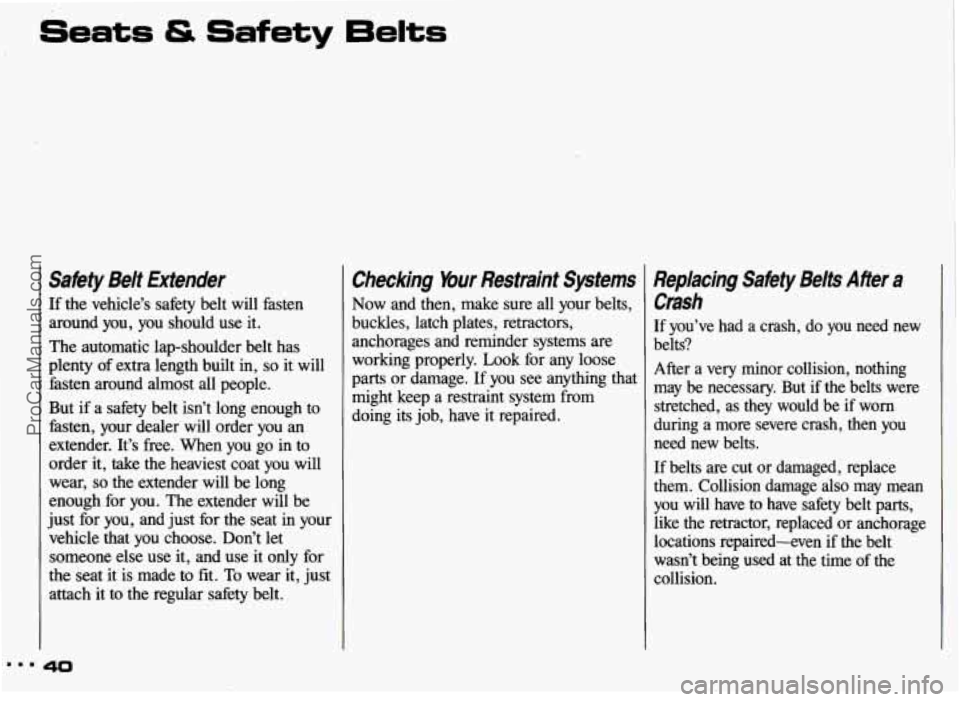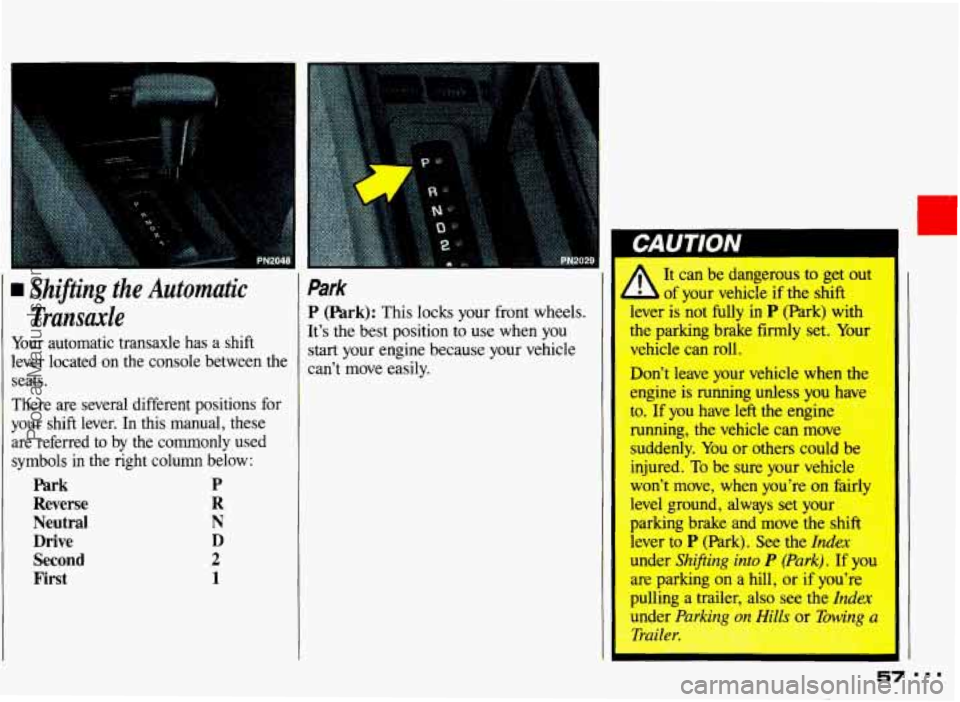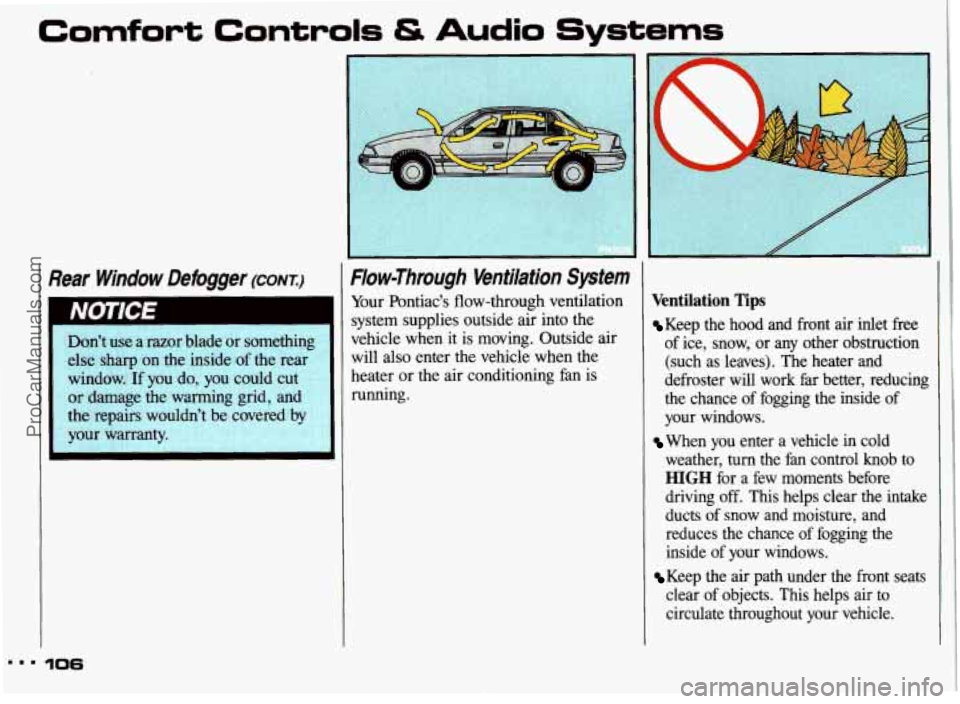Page 33 of 306
Seats & Safety 6elts
Securing a Child Restraint in a
Rear Outside Position (CONK:)
See if the shoulder belt would go in
front of the child's face or neck. If
so, put it behind the child restraint.
4. Buckle the belt. Make sure the
release button faces upward or
outward,
so you'll be able to un-
buckle it quickly if you ever need to.
5. To tighten the belt, pull up on the
shoulder belt while you push down
on the child restraint.
6. Push and pull the child restraint in
different directions to be sure it is
secure.
To remove the child restraint, just
unbuckle the vehicle's safety belt and let
it
go back all the way. The safety belt
will move freely again and be ready to
work for an adult or larger child
passenger.
ProCarManuals.com
Page 37 of 306
Seats & Safety 6elts
Securing a Child Restraint in the
Right Front Seat
(CONT.)
3. Put the belt’s special latch plate into
the vehicle’s safety belt buckle.
36
4. You can make the belt longer by 8. Put the hook on the free end through
tilting the buckle and pulling it along the slot
in the latch plate.
the belt.
the instructions for the child
restraint.
6. Secure the child in the child restraint
as the instructions say.
7. Run the belt through or around the
child restraint. The child restraint
instructions will show you how.
5. Put the restraint on the seat. Follow
ProCarManuals.com
Page 39 of 306
Seats & Safety 6elts
Larger Children
Children who have outgrown child
restraints should wear the vehicle's
safety belts.
If you have the choice, a child should sit
next to a window
so the child can wear
a lap-shoulder belt and get the
additional restraint a shoulder belt can
provide.
Accident statistics show that children are
safer
if they are restrained in the rear
seat. But
they need to use the safety
belts properly.
Children who aren't buckled up can be
thrown out
in a crash.
Children who aren't buckled up can
strike other people who are.
2061 -
Never do this.
A Here two children are wearing
the same belt. The belt can't
properly spread the impact forces.
In a crash, the two children can be
crushed together and seriously injured. A belt must be used by
only one person at
a time. I
msm 38
ProCarManuals.com
Page 41 of 306

Seats & Safety 6elts
Sahty Belt Extender
If the vehicle’s safety belt will fasten
around you, you should use it.
The automatic lap-shoulder belt has
plenty of extra length built in,
so it will
fasten around almost all people.
But if a safety belt isn’t long enough to
ksten, your dealer will order you an
extender. It’s free. When you go in to
order it, take the heaviest coat you will
wear,
so the extender will be long
enough for
you. The extender will be
just for you, and just for the seat
in your
vehicle that you choose. Don’t let
someone else use it, and use it only for
the seat it is made to fit. To wear it, just
attach it to the regular safety belt.
Checking Your Restraint Systems
Now and then, make sure all your belts,
buckles, latch plates, retractors, anchorages and reminder systems are
working properly.
Look for any loose
parts or damage. If you
see anything that
might keep a restraint system
from
doing its job, have it repaired.
Replacing Satiety Belts After a
Crash
If you’ve had a crash, do you need new
belts?
After a very minor collision, nothing may be necessary.
But if the belts were
stretched, as they would be if worn
during a more severe crash, then you
need new belts.
If belts are cut or damaged, replace
them. Collision damage
also may mean
you will have to have safety belt parts, like the retractor, replaced or anchorage
locations repaired-even if the belt
wasn’t being used at
the time of the
collision.
888 40
ProCarManuals.com
Page 58 of 306

Shifting the Automatic Transaxle
Your automatic transaxle has a shift
lever located on the console between the
seats.
There are several different positions for
your shift lever. In this manual, these
are referred
to by the commonly used
symbols in the right column below:
Park P
Reverse R
Neutral N
Drive D
Second 2
First 1
Park
P (hrk): This locks your front wheels.
It’s the best position to use when you
start your engine because your vehicle
can’t move easily.
I I
It can be dangerous to get out
b of your vehicle if the shift
hever is not fully in
P (Park) with
the parking brake firmly
set v-*7
vehicle can roll
Don’t leave your venue
WI I me
engine is running unless you llavr
to. If you have left the engine
running, the vehicle can move
suddenly. You or others could be
injured. To be sure your vehicle
won’t move, when you’re on fair1
level ground, always set your
parking brake and move the shift
lever to
P (Park). See the Index
under Shifting into P (Park). If you
are parking
on a hill, or if you’re
pulling a trailer, also see the
Index
under Parking on Hills or %wing a
Trailer.
ProCarManuals.com
Page 107 of 306

Comfort Controls & Audio Systems
I
Rear Window Defogger (CONT.:) I Flow-Through Ventilation System
Don’t use a razor blade or something
else
sharp on the inside of the rear
window. If you do,
you could cut
or damage the warming grid, and
the repairs wouldn’t be covered by
your warranty Your Pontiac’s
flow-through ventilation
system supplies outside air into the
vehicle when it is moving. Outside air
will also enter the vehicle when the
heater or the air conditioning fan is
running.
Ventilation Tips
Keep the hood and front air inlet free
of ice, snow, or any other obstruction
(such as leaves). The heater and
defroster will work far better, reducing the chance of fogging the inside of
your windows.
When you enter a vehicle in cold
weather,
turn the fan control knob to
HIGH for a few moments before
driving off. This helps clear the intake
ducts of snow and moisture, and
reduces the chance of fogging the
inside of your windows.
clear of objects. This helps air to
circulate throughout your vehicle.
Keep the air path under the front seats
ProCarManuals.com
Page 232 of 306

IIC
A
Do not load your vehicle any
heavier
than the GVWR or the
maximum
front and rear CiAWRs.
If you do, parts on your vehicle
can
break, or it can change the way
your vehicle handles. These could
cause you to lose control. Also,
overloading
can shorten the life of
your vehicle.
I Your warranty does not cover parts 1
I
or component
overloading.
If you put things inside your vehicle-
like suitcases, tools, packages,
or
anything else-they will go as fast as the
vehicle goes.
If you have to stop or turn
quickly, or if there is a crash, they’ll
keep going.
A
CAUTION
Things you put inside your I
vehicle can strike and injure
people in a sudden stop or turn, or
in a crash.
0 Put things in the tnuik of your
vehicle. In a trunk, put them as
far forward as you can.
* Try tu spread the weight evenly.
Never stack heavier things, like
suitcases, inside the vehicle so
that some of them are above the
tops
of the seats.
When you carry something
inside
the vehicle, secure it
whenever
you can.
Don’t leave a seat folded down
unless you
need to. 1:
iE31 ’
ProCarManuals.com
Page 250 of 306

Fuse Rating Circuitry
Fuse Usage
HORN
ALARM
HTR-A/C
RDO IGN
TURN
DR LK
TAIL LPS
WDO
WIPER ERLS
FTP
ACC
IGN ECM
HDLP
15
15
25
10
20
20
20
30
25
15
20
30
20
20
Back Up Lights, Electronic PRNDL (automatic transaxle)
Fuel Pump, Fuel Injectors
Turn/Hazard/Stop Lights, Anti-Lock Brakes
(ABS), Brake-
Transaxle Shift Interlock
(BTSI)
Power Door Locks, Power Mirrors, Cigar Lighter
BLANK
Instrument Panel Lights
Rear Window Defogger Relay, Chime, Gages,
ABS , BTSI,
Daytime
Running Lights (Dm) (Canada)
Horn
Chime, Interior Lights, Passive Restraints, Radio/Clock Memory
Heater, Air Conditioning, ABS, DRL (Canada), Engine Block
Heater
Radio, Cruise Control, Variable
Effort Steering
Turn Signals
Power Door Locks
Exterior Lights, Fog Lights, Instrument Panel Lights, DRL
(Canada)
Power Windows (Circuit Breaker)
Windshield WipedWasher
Engine Controls, Starter and Charging System
BLANK
Flash-to-Pass
(US.)
Power Seats, Rear Window Defogger (Circuit Breaker)
BLANK
Engine Control Module, Ignition System
BLANK
Headlights, DRL (Canada) (Circuit Breaker)
ProCarManuals.com
Page:
< prev 1-8 9-16 17-24